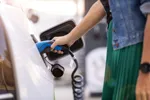As a stock exchange listed company, Carillion’s fleet policy has to sit hand in glove with the needs of its shareholders. Two factors drive the strategy: cost and health and safety.
Running costs need to be kept to a minimum – the focus is on replacement cycles, fuel bills and rental costs - while a Target Zero programme aims to wipe out reportable incidents by next year.
Both would be challenging enough for most fleets. For Gil Kelly, fleet management director of the £90 million turnover fleet division, the difficulty quotient has been multiplied by a fleet that has almost doubled in size over the past three years through acquisitions and organic growth.
Following the purchase of Mowlam in February 2006, which added a couple of thousand vehicles, and McAlpine two years later, which added another 2,500 units plus 1,500 daily rental and 200 HGVs, Carillion’s fleet totals 14,000 vehicles.
Of those, 10,000 are internal and 4,000 are external, managed for customers. Around 70% are commercials, from vans to heavy goods, while 60% of the cars are essential user.
Integration of the Mowlam and McAlpine fleets happened at breakneck speed – the latter took just seven weeks.
One of the biggest changes centred on the rental fleet. Kelly introduced tighter authorisation and detailed reporting requirements to challenge McAlpine’s high numbers.
He also brought in a 1.2-litre policy to better manage the costs and to encourage people out of daily rental and into Carillion’s reallocation system.
“The 1.2 policy improves fuel savings but still provides a vehicle that fits within our heath and safety standards,” Kelly says. “Our daily rental costs will fall by around 30% this year.”
Like many of his fleet counterparts, Kelly has been evaluating the optimum length of leases. Cars have been extended from 36 months to 42 months; vans are now 48 months, although some commercial vehicles run for seven years.
“Optimum includes practicality, fit for purpose, health and safety, sustainability and carbon footprint,” Kelly says. It’s not simply a question of reducing costs.
The environment is rising up the agenda, driven by the needs of customers, Government taxation and its link with fuel costs. The fleet operation accounts for more than 70% of Carillion’s carbon footprint. “It has to be reduced,” says Kelly.
Most cars are now below 160g/km CO2 and grades are being introduced into the seven bands to push emissions down further. Carillion has added Volkswagen Bluemotion and Ford Econetic to the fleet and is also pushing the benefits of the Toyota Prius.
It is also paying close attention to the newly released van CO2 data and already makes Euro 5 compliant engines a must for vans and HGVs.
Earlier this year Carillion held a ‘sustainability week’ where the cars were made available for staff to driver. It changed their perceptions and led to a surge in demand for the greener vehicles.
By 2012, the fleet is tasked with reducing CO2 emissions by 50% compared to 2008 levels.
“Sustainability is high up the agenda. We have a group forum with external people sat on the board, including Jonathan Porrit . It challenges us to be better,” says Kelly.
CO2 reduction means fuel reduction. Carillion has de-centralised responsibility for fuel management to its individual fleets (the business is spread across four divisions - Business Services, Building, Infrastructure and International).
It has just started analysing the data but is already seeing savings thanks to the greater transparency on fuel spend in each business unit.
Those savings should be heightened by trials of telematics. Masternault units have been installed on 1,800 vehicles with a view to rolling it out across the fleet. Carillion has also recently started trialling fuel saving devices which alter the performance of the engine management system.
Together with investment in teleconference facilities to reduce fleet mileage, these actions are expected to slice 10-15% off Carillion’s annual £28 million fuel bill.
Potentially the biggest saving any fleet can make centres on accident reduction; it’s also entwined with the health and safety strategy.
Carillion benchmarks its heath and safety performance internally and externally and accident frequency is a key focus. Accidents are costly and not just in terms of the actual vehicle repairs. Third party costs, vehicle downtime and the impact on insurance premiums can quadruple the bill.
In July, Carillion introduced a ‘bumps and bangs’ policy. It highlights to staff how many accidents occur each year and the cost to the business, and emphasises how they can help.
“By explaining the situation it puts the onus and responsibility on to the individual,” says Kelly. “There will be a notional charge for at fault accidents, but it’s more about a behavioural change within the business.”
Driver assessments categorise staff into one of 11 groups. Four of those groups will require training – criteria include an accident within the past 12 months, age and mileage.
“We want to reduce our accident rate by 10% this year and next year,” says Kelly. “It’s an aggressive target but we can get there by increasing awareness of the issue, through driver training and risk management, and by putting the onus onto the individual.”
Savings are crucial – no matter how small
Account manager Pat Burn oversees 4,668 vehicles on the Carillion fleet, of which 4,200 are internal units.
His role is to find cost savings, both internally and for his end user customers, no matter how small.
“For instance, roof racks can add £126 a year in fuel costs,” he says. “Companies weren’t bothered about this sort of saving in the past but with all the redundancies and focus on cost, they are very interested now.”
Electric vehicles are also gaining in popularity since Carillion added some Smiths Electric vehicles to its fleet.
Carillion contract hires out the electric vehicle and manages the service, maintenance and repair. They have attracted companies that need an additional selling point when tendering for business.
“We’ve had positive feedback on the electric vehicles,” Burn says. “There have been no technical hiccups and no downtime for repairs. Only the brakes and tyres need maintaining and in some London boroughs, such as Beckton, there’s no road fund licence because they are classed as milk floats – that means no car parking charges which is saving some companies a lot of money.”
Carillion is running the vehicles over six and seven year contracts written against a zero residual value. “We hope that by the time we get rid of them there will be a second hand market,” Burn adds.
When he joined the business almost seven years ago, the focus was on getting vehicles onto the road and growing the business.
“Now it’s about sustainability, Target Zero, health and safety, cost awareness, CO2, fuel efficiency – it’s changed a lot,” he says. “But it’s never static; I’m always looking at new things, assessing new products.”
















Login to comment
Comments
No comments have been made yet.